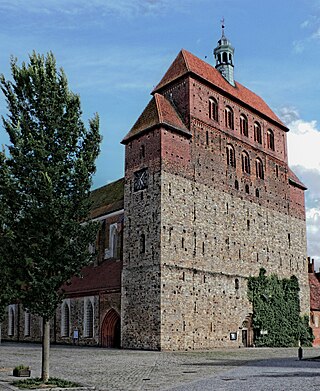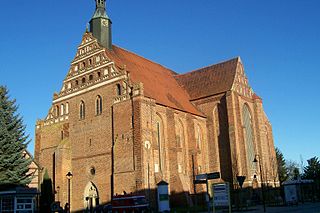
The Havel is a river in northeastern Germany, flowing through the states of Mecklenburg-Vorpommern, Brandenburg, Berlin and Saxony-Anhalt. The 325 kilometres (202 mi) long Havel is a right tributary of the Elbe. However, the direct distance from its source to its mouth is only 94 kilometres (58 mi). For much of its length, the Havel is navigable; it provides an important link in the waterway connections between the east and west of Germany, as well as beyond.
Prignitz is a Kreis (district) in northwestern Brandenburg, Germany. Neighboring districts, clockwise from the north, are Ludwigslust-Parchim, Ostprignitz-Ruppin (Brandenburg), Stendal (Saxony-Anhalt), and Lüchow-Dannenberg.

The Altmark is a historic region in Germany, comprising the northern third of Saxony-Anhalt. As the initial territory of the March of Brandenburg, it is sometimes referred to as the "Cradle of Prussia", as by Otto von Bismarck, a native of Schönhausen near Stendal.

Wittenberge is a town of eighteen thousand people on the middle Elbe in the district of Prignitz, Brandenburg, Germany.

Perleberg is the capital of the district of Prignitz, located in the northwest of the German state of Brandenburg. The town received city rights in 1239 and today has about 12,000 inhabitants. Located in a mostly agricultural area, the town has a long history of troops being stationed there and as an administrative center for local government.

Havelberg is a town in the district of Stendal, in Saxony-Anhalt, Germany. It is situated on the Havel, and part of the town is built on an island in the centre of the river. The two parts were incorporated as a town in 1875. It has a population of 6,436 (2020).

Lenzen (Elbe) is a small town in the district of Prignitz, in Brandenburg, Germany. The town lies to the north of the Löcknitz River, not far from where the Löcknitz flows into the Elbe. It is part of the Amt Lenzen-Elbtalaue.

Wittstock/Dosse is a town in the Ostprignitz-Ruppin district, in north-western Brandenburg, Germany.

Heiligengrabe is a municipality in the Ostprignitz-Ruppin district, in Brandenburg, Germany.

Weisen is a municipality in the Prignitz district, in Brandenburg, Germany. It consists of the main village Weisen, the small settlement Waldhaus and the village Schilde.

The Bishopric of Havelberg was a Roman Catholic diocese founded by King Otto I of Germany in 946, from 968 a suffragan to the Archbishops of Magedeburg. A Prince-bishopric (Hochstift) from 1151, Havelberg as a result of the Protestant Reformation was secularised and finally annexed by the margraves of Brandenburg in 1598.

The Holy Blood of Wilsnack was the name given to three hosts, which survived a fire in 1383 that burned the church and village to the ground. The hosts were thus seen as miraculous. The relics became the destination of medieval religious pilgrimages to Bad Wilsnack, Germany for nearly two centuries. Revenue from the many pilgrims enabled the town to build the large St. Nicholas' Church at the site. The hosts were destroyed by reformers in 1558 during the Protestant Reformation.
Dietrich Man, known as Dietrich II, was Bishop of Havelberg from 1370 to 1385.

Amt Bad Wilsnack/Weisen is an Amt in the district of Prignitz, in Brandenburg, Germany. Its seat is in Bad Wilsnack.

In the Slavic revolt of 983, Polabian Slavs, Wends, Lutici and Obotrite tribes, that lived east of the Elbe River in modern north-east Germany overthrew an assumed Ottonian rule over the Slavic lands and rejected Christianization under Emperor Otto I.

The Plattenburg is a water castle in the independent municipality of Plattenburg in the German district of Prignitz in northwestern Brandenburg. It was first documented in 1319, making it the oldest surviving water castle in northern Germany.

Glöwen station is the station of the town of Glöwen, which is in the municipality of Plattenburg and the German state of Brandenburg. It lies on the Berlin–Hamburg Railway and was opened in 1846. The Glöwen–Havelberg railway branched at the station from 1890 to 1971. The former Light Railway of the District of West and East Prignitz from Viesecke, a small town now in the municipality of Plattenburg, ended in Glöwen from 1900 to 1967. The Neoclassical entrance, which was built at the same time as the line, has heritage protection.
Linum is a village of the municipality Fehrbellin in the Ostprignitz-Ruppin district of Brandenburg, Germany. It is sometimes called the "stork village" (Storchendorf) of Linum.

Bad Wilsnack station is a railway station in the municipality of Bad Wilsnack, located in the Prignitz district in Brandenburg, Germany.























